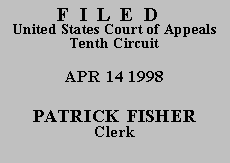

| GEORGE LEE MILLER,
v.
RICHARD MARR; ATTORNEY
GENERAL FOR THE STATE OF
COLORADO |
|
Appeal from the United States District Court
for the District of Colorado
(D.C. No. 97-S-1628)
George Miller, pro se.
Mr. Miller pled guilty to second degree murder and attempted second degree assault in Colorado in 1989. He was sentenced to forty years and thirteen years on the respective convictions, the sentences to run consecutively. He unsuccessfully appealed to the Colorado Court of Appeals, and the Colorado Supreme Court denied certiorari on March 25, 1991. Thereafter, Mr. Miller filed a motion for state postconviction relief, unsuccessfully appealed to the Colorado Court of Appeals, and the Colorado Supreme Court denied certiorari on October 4, 1993.
In his petition dated July 10, 1997, Mr. Miller raises two grounds for relief: (1) he was given an unduly harsh sentence, and (2) he received inadequate advice that his sentences could be consecutive upon entering his plea. He indicates that the first ground was raised on direct appeal; the second was raised in his motion for postconviction relief. To avoid the one-year limitation period, Mr. Miller was required to file prior to April 24, 1997, one year after the enactment of the AEDPA. See United States v. Simmonds, 111 F. 3d 737, 746 (10th Cir. 1997).
Mr. Miller contended below that the one-year limitation on filing a first habeas petition violated the Suspension Clause, U.S. Const. art. I, § 9, cl. 2, the Constitution's prohibition on suspending the writ. Whether the one-year limitation period violates the Suspension Clause depends upon whether the limitation period renders the habeas remedy "inadequate or ineffective" to test the legality of detention. Swain v. Pressley, 430 U.S. 372, 381 (1977); United States v. Hayman, 342 U.S. 205, 223 (1952). The burden is on the petitioner to demonstrate inadequacy and ineffectiveness. See Bradshaw v. Story, 86 F.3d 164, 167 (10th Cir. 1996).
In Felker v. Turpin, 116 S. Ct. 2333 (1996), the Court held that restrictions on filing successive petitions did not constitute a suspension of the writ, but did not address restrictions on filing a first petition. See id. at 2339-40. In Lonchar v. Thomas, 116 S. Ct. 1293 (1996), the Court disapproved of dismissal of a first federal habeas petition on equitable grounds outside of the statutory rule concerning delayed petitions, Rule 9(a) of the Rules Governing § 2254 Cases in the United States District Courts. See id. at 1303. The Court distinguished between successive petitions and first federal habeas petitions: "Dismissal of a first federal habeas petition is a particularly serious matter, for that dismissal denies the petitioner the protections of the Great Writ entirely, risking injury to an important interest in human liberty." Id. at 1299. At the same time, the Court expressed a clear deference to the rules that Congress has fashioned concerning habeas. See id. at 1298.
There may be circumstances where the limitation period at least raises serious constitutional questions and possibly renders the habeas remedy inadequate and ineffective. Cf. Treistman v. United States, 124 F.3d 361, 373-380 (2d Cir. 1997) (§ 2255). After considering the claims Mr. Miller desires to raise, however, we are satisfied that such circumstances are not implicated here. It must be remembered that § 2244(d) is not jurisdictional and as a limitation may be subject to equitable tolling. See Calderon v. United States District Court, 128 F.3d 1283, 1287-88 (9th Cir. 1997), cert. denied, 118 S. Ct. 899 (1998). Moreover, Mr. Miller does not contend, for example, that a constitutional violation has resulted in the conviction of one who is actually innocent or incompetent. See Schlup v. Delo, 513 U.S. 298, 324-29 (1995); Cooper v. Oklahoma, 517 U.S. 348, 116 S. Ct. 1373, 1376-77 (1996). The one-year time period begins to run in accordance with individual circumstances that could reasonably affect the availability of the remedy, see 28 U.S.C. § 2244(d)(1)(B)-(D); see also Calderon, 128 F.3d at 1289 (limitation period tolled for extraordinary circumstances over which inmate had no control), but requires inmates to dillegently pursue claims.
Mr. Miller had from October 4, 1993 to file his federal habeas petition. He had an additional year after the enactment of AEDPA given this circuit's decision in Simmonds. Mr. Miller contends that because he was housed at a private Minnesota correctional facility from January 21, 1995 until April 29, 1997, he lacked access to federal statutes and Colorado case law and only learned upon his return of the AEDPA's one-year time period. See R. doc. 7 at 2. Of course, this does not explain Mr. Miller's lack of pursuit of his federal claims before the transfer from Colorado to Minnesota, from October 4, 1993 until January 20, 1995. We note that the claims Mr. Miller sought to raise are similar to those raised in his direct appeal and motion for state postconviction relief, thereby undercutting his argument that lack of access caused his delay. In the final analysis, however, Mr. Miller has provided no specificity regarding the alleged lack of access and the steps he took to diligently pursue his federal claims. Cf. Lewis v. Casey, 116 S. Ct. 2174, 2179 (1996). It is not enough to say that the Minnesota faciltiy lacked all relevant statutes and case law or that the procedure to request specific materials was inadequate. See Aplt. Br. (Form A-11) at 10. It is apparent that Mr. Miller simply did not know about the limitation in the AEDPA until it was too late.
AFFIRMED.
*. After examining the briefs and the appellate record, this three-judge panel has determined unanimously that oral argument would not be of material assistance in the determination of this appeal. See Fed. R. App. P. 34(a); 10th Cir. R. 34.1.9. The cause is therefore ordered submitted without oral argument.